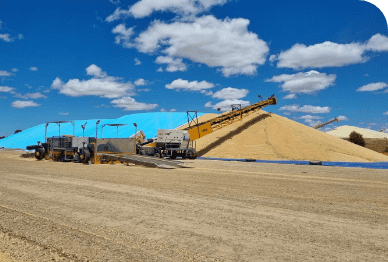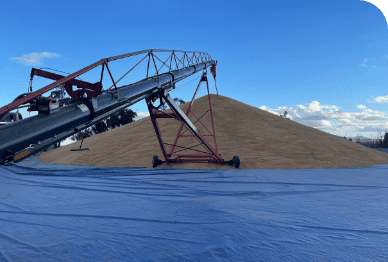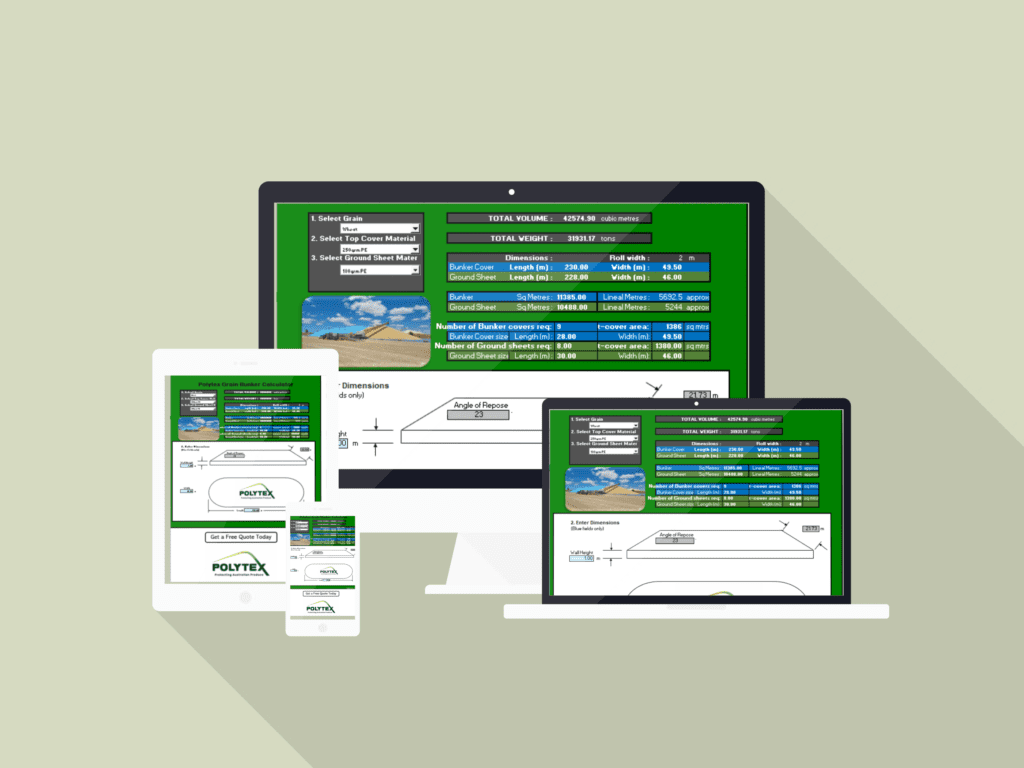Home / Shop / Livestock Shelters / Feedlots & Sale Yard Shelters / Cattle Protection / Bunker Walls
Are earth walls a good option for a grain bunker?
Yes, earth walls for grain bunkers are a good option and have been used for decades. Typically, you would make earth walls on 3 sides of your bunker, forming a U-shape. Leave one end open for access when inloading and outloading. The earth wall must slope away from the pad. Earth walls can be formed from using soil from the immediate surrounding area outside the pad. This creates a channel around the pad to collect and drain water run-off from the covers.
Are earth walls better than no walls for a grain bunker?
If you have earth moving machinery readily available, earth walls are a better option, providing more capacity and are also help deter rodent pests. However, having no walls is a common method and the most simple. Lay your ground sheet out on your pad and once the grain is dumped and top cover pulled over, seal the top tarp to the ground sheet with concrete tyres or dirt. Dirt, however, can cause tarp damage when seeking to pull it off. Having no walls is a cost-efficient and quick option.
Are concrete walls or steel walls best for grain bunkers?
Concrete walls are a popular option for long-term bunker storage. Concrete walls significantly increase the capacity of your bunker on the same size pad, and can make sealing your bunker easier with clamps and rails providing a tight seal. Walls are usually arranged in a U-shape around three edges of the pad, with an open end for access when inloading or outloading. Avoid a square-ended bunker as you will need to push or dump grain into the corners to avoid a depression where water can sit.
Steel walls are a lower cost option to concrete walls however they do present some challenges. Steel sweats therefore the moisture runs down the inside of the walls. Steel Walls are also typically on a slant making site hygiene around the bunker a harder process. i.e. excess grain has to be broomed by hand rather than using equipment along the edge of the bunker.
Concrete walls are a better option than steel walls for grain bunkers, mainly due to the fact that steel sweats, releasing moisture into the grain whereas concrete absorbs moisture. Also site hygiene is easier with concrete walls than steel walls.
$600.00
For tips on successful bunker site preparation – download our Grain Bunker Construction Guide
Polytex precast concrete bunker walls for grain bunkers. A popular wall solution for long term bunker storage. A proven design featuring a curved top edge with holes for clamps provide superior sealing for fumigation.
Concrete walls significantly increase the capacity of your grain bunker on the same size pad, and can make sealing your bunker easier with clamps and rails providing a tight seal. Walls are usually arranged in a U-shape around three edges of the pad, with an open end for access when inloading or outloading.
Clamps and rails are available.
FEATURES:
SPECIFICATIONS:
L-Shaped Concrete Walls also available in different heights. Popular for silage pits and varied other uses.
Are earth walls a good option for a grain bunker?
Yes, earth walls for grain bunkers are a good option and have been used for decades. Typically, you would make earth walls on 3 sides of your bunker, forming a U-shape. Leave one end open for access when inloading and outloading. The earth wall must slope away from the pad. Earth walls can be formed from using soil from the immediate surrounding area outside the pad. This creates a channel around the pad to collect and drain water run-off from the covers.
Are earth walls better than no walls for a grain bunker?
If you have earth moving machinery readily available, earth walls are a better option, providing more capacity and are also help deter rodent pests. However, having no walls is a common method and the most simple. Lay your ground sheet out on your pad and once the grain is dumped and top cover pulled over, seal the top tarp to the ground sheet with concrete tyres or dirt. Dirt, however, can cause tarp damage when seeking to pull it off. Having no walls is a cost-efficient and quick option.
Are concrete walls or steel walls best for grain bunkers?
Concrete walls are a popular option for long-term bunker storage. Concrete walls significantly increase the capacity of your bunker on the same size pad, and can make sealing your bunker easier with clamps and rails providing a tight seal. Walls are usually arranged in a U-shape around three edges of the pad, with an open end for access when inloading or outloading. Avoid a square-ended bunker as you will need to push or dump grain into the corners to avoid a depression where water can sit.
Steel walls are a lower cost option to concrete walls however they do present some challenges. Steel sweats therefore the moisture runs down the inside of the walls. Steel Walls are also typically on a slant making site hygiene around the bunker a harder process. i.e. excess grain has to be broomed by hand rather than using equipment along the edge of the bunker.
Concrete walls are a better option than steel walls for grain bunkers, mainly due to the fact that steel sweats, releasing moisture into the grain whereas concrete absorbs moisture. Also site hygiene is easier with concrete walls than steel walls.

Polytex Bunker Covers or Bunker Tarps can include tarp stenciling to your specifications

Polytex has a vast network of recommended & competent carriers Australia wide.

Polytex uses only first quality industrial fabrics for the manufacture of all products; well-known brands including Canvacon, Tarpee & Landmark variations

Access our calculator to get a comprehensive guide to planning and designing your grain storage.